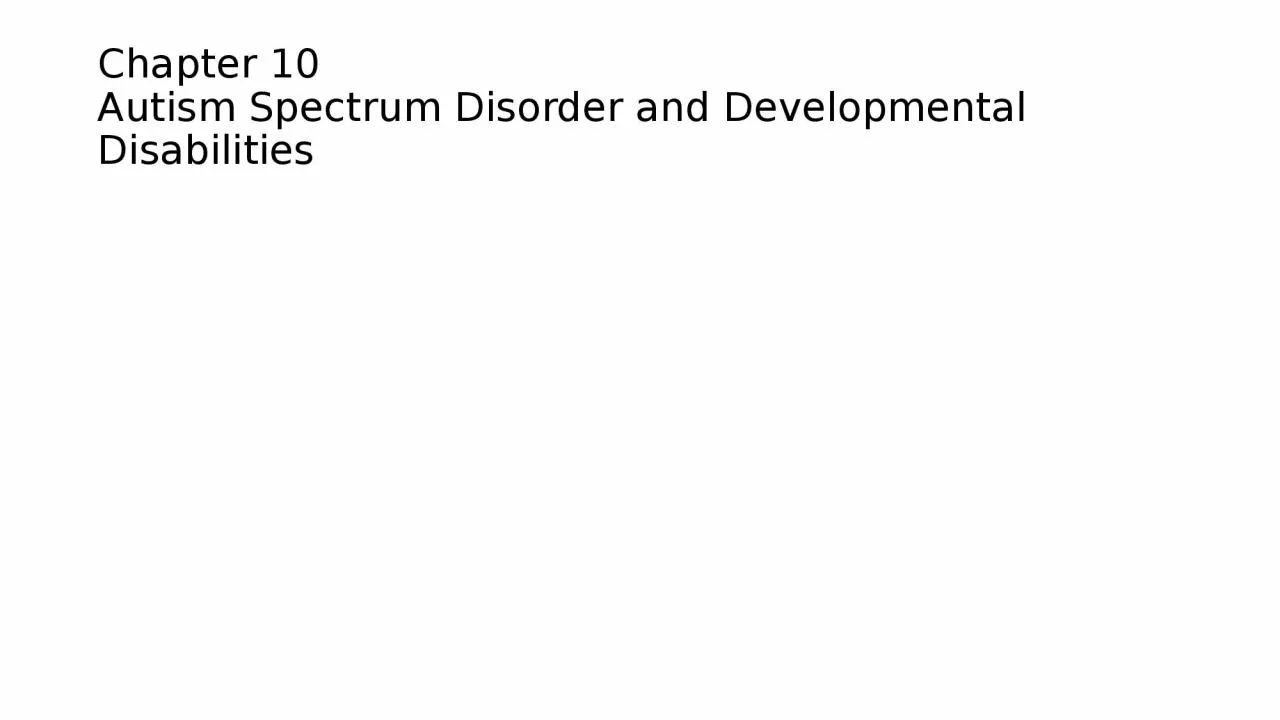

Outline I Developmental Disabilities II Autism Spectrum Disorder III Additional Considerations for Individuals with Autism Spectrum Disorder and Developmental Disabilities I DEVELOPMENTAL DISABILITES ID: 1045364
Download Presentation The PPT/PDF document "Chapter 10 Autism Spectrum Disorder and ..." is the property of its rightful owner. Permission is granted to download and print the materials on this web site for personal, non-commercial use only, and to display it on your personal computer provided you do not modify the materials and that you retain all copyright notices contained in the materials. By downloading content from our website, you accept the terms of this agreement.
1. Chapter 10Autism Spectrum Disorder and Developmental Disabilities
2. OutlineI. Developmental DisabilitiesII. Autism Spectrum DisorderIII. Additional Considerations for Individuals with Autism Spectrum Disorder and Developmental Disabilities
3. I. DEVELOPMENTAL DISABILITES**A. FoundationsThe term Developmental Disability (DD) encompasses intellectual disability (ID) and physical disabilities like cerebral palsyWe will focus on ID
4. General characteristics of individuals with ID include:
5. World wide, 1-2% of people have ID**Most have mild IDID is almost twice as common in low- and middle-income countries compared to high income countries
6. Risk factors for ID:
7. B. Speech and Language Characteristics of Persons with DDs**Speech sound disordersMay speak more slowlyReceptive language skills commensurate with mental age with expressive skills being much more limitedUnderstand concrete information better than abstract information
8. For example:**They might have difficulty understanding the term “acquatic”But they will easily understand “water”
9. Expressive language is one of the most challenging areas for children with DD:**Limited vocabularyFew synonyms (e.g., happy, delighted, glad, joyful)Difficulty describing characteristics of objects (color, size, shape, function)Limited conversational skills
10. C. Down Syndrome—Trisomy Syndrome—Chromosome 21**More common in older momsSmall head, ears, other distinguishing physical characteristicsMay be short in statureOften happy, cheerful, affectionateMany get some education
11. In terms of speech, children with Down Syndrome
12. Children with Down Syndrome:
13. Check out this TEDx talk by a woman with Down Syndrome!https://www.youtube.com/watch?v=HwxjoBQdn0s
14. II. AUTISM SPECTRUM DISORDER**A. Background1 in 36 children have ASDNot on exam: in Sacramento, the rate of children with ASD increased by 400% in recent yearsHighest incidence is in Qatar; lowest is in France
15. Not on exam:
16. Conditions associated with ASD:**GeneticsMaternal exposure to pesticides and heavy metals during pregnancy (field workers are very vulnerable)
17. B. Common Characteristics of Children with ASD:**Lack of attempts to connect with caregiversReduced joint attentionExtreme distress reactionsMay fixate on particular objectsPossible repetitive behaviorsInflexible adherence to routinesRestricted interests
18. Communication “Red Flags” Worldwide
19. Unfortunately, children from bilingual homes may be overlooked and undiagnosed:**Pediatricians tell parents that “your child is confused by 2 languages at home”“They will outgrow it.”
20. B. Features Associated with ASD**Sensory processing disorder—more than 90% of children with ASD have atypical sensory behaviorsMay be very sensitive to loud sounds, smells, bright lightsADHDDepression—social isolation, exclusion, unemployment
21. Other features associated with ASD:
22. C. Language and Social Skill Challenges** Social (pragmatic) communication disorderChallenges with theory of mind (TOM)—understanding other people’s perspectivesDifficulty understanding how their behavior impacts othersDifficulty understanding emotionsLack of eye contact
23. Hearing issues:
24. D. Assessment
25. Assessment is comprehensive and includes:
26. Language skills that SLPs assess:**Speech—articulationReceptive language—comprehensionFrequency and function of verbal (vocalizations/verbalizations) and nonverbal communication (e.g., gestures)
27. We especially evaluate social communication and conversational skills:**Joint attentionPlay behaviorUse of gesturesInitiation of communication
28.
29. E. Intervention for Individuals with ASD**Goal: quality of life, social acceptanceApplied behavior analysis—ABA—skills are broken down and taught one step at a timeNaturalistic intervention—based on ABA—used in daily routinesFor example, we would work on joint attention, vocal turntaking
30. It’s very important…**To utilized a strengths-based approachTo celebrate neurodiversityDr. Temple Grandin is an internationally famous author and speaker with ASD
31. The World Needs All Kinds of Minds**https://www.youtube.com/watch?v=fn_9f5x0f1QDr. Temple GrandinWe will watch 1-2 minutes
32. Thankfully, research is showing that:
33. III. ADDITIONAL CONSIDERATIONS FOR INDIVIDUALS WITH ASD AND DD**They should be placed in the least restrictive environment (LRE) in the schoolsIt’s important for children to spend some time with typically-developing peersOften they will be in a special day class but be mainstreamed into PE, art, music, lunch
34. There may be substantial emotional issues for the children and families:**ASD is typically hardest on familiesThey often feel stigmatizedChildren are very vulnerable to bullying
35. Individuals with ASD and DD are vulnerable to abuse:
36. OutlineI. Developmental DisabilitiesII. Autism Spectrum DisorderIII. Additional Considerations for Individuals with Autism Spectrum Disorder and Developmental Disabilities